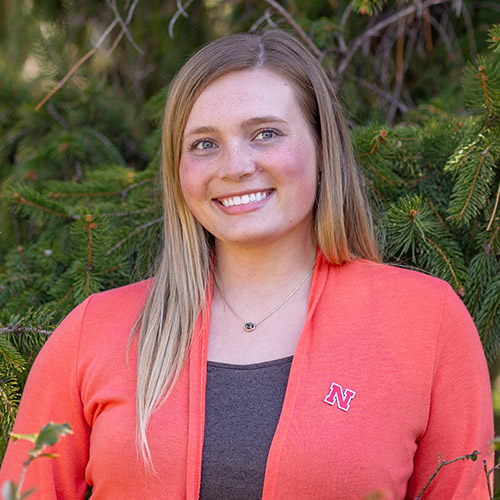
Mighty Mice: The Nebraska Gnotobiotic Mouse Program
Germ-Free Mice Help Understand the Human Gut

The human gut—including the microbes that live there—can influence the overall health of an individual. At birth, humans begin acquiring the trillions of bacteria, yeast, viruses, etc., that can ultimately have either a positive or negative effect on their health. Together, this ultra-dense ecosystem is referred to as the gut microbiome, and every person’s microbiome is different.
Not only does the microbiome affect a person’s gastrointestinal health, it can also influence our cardiovascular and neurological systems, making research on the gut a critical component to advancing human health.
Amanda Ramer-Tait, associate professor in the Department of Food Science and Technology at the University of Nebraska–Lincoln studies how gut microbes impact human health in the Nebraska Gnotobiotic Mouse Program.
“The word ‘gnotobiotic’ comes from the Greek words ‘gnoto’ (known) and ‘bios’ (life). In a gnotobiotic mouse, we know exactly what microbial life is present in that animal,” Ramer-Tait said. “We can control which microbes are living in the gut of a gnotobiotic mouse, making them an excellent model for understanding the complexities of the human microbiome.”
The Human Microbiome: Our Partner
Organisms that make up a human gut microbiome are actually there for the purpose of “good.”
“These organisms are essential to human health – they help with digestion by breaking down complex carbohydrates as well as synthesize vitamins that humans cannot make,” Ramer-Tait said.
The human gut microbiome also is important for training a person’s immune system and providing protection against intestinal pathogens.
“Our gut microbes can also provide colonization resistance by crowding out potential pathogens, such as Clostridioides difficile—also known as C. diff,” Ramer-Tait said. “Microbes in the gut are our partners – they are here to help.”
Ultimately, gut microbes are considered the “good guys” from the standpoint of helping shape human health.
However, under certain circumstances, Ramer-Tait said microbes can also contribute to diseases. For example, a person may have a genetic predisposition for an inflammatory bowel disease such as Crohn’s disease or ulcerative colitis. While gut microbes may not the initial cause of those issues, they may be catalysts for the disease.
“An important challenge is to determine which of our gut organisms can turn out to be harmful and how they can contribute to starting or worsening disease,” Ramer-Tait said.
Ramer-Tait and her team work to understand these challenges but they also look for solutions. Many microbiome researchers have shown that diet can dramatically alter the gut microbiome, which means it may be possible to one day determine specific diet suggestions for humans with health issues.
Mice Help Understand the Human Gut
The Nebraska Gnotobiotic Mouse Program is a key resource for studying how gut microbes influence health and disease as well as how diet can shape the human microbiome, Ramer-Tait said.
“A gnotobiotic mouse (one without its own microbes) can become an avatar for a person,” Ramer-Tait said. “We can colonize these mice with a specific person’s gut microbiome and determine whether a particular dietary intervention can change that microbiome to improve the health of the mouse.”
Mice are raised in the lab and born germ-free, meaning they have no bacteria in their bodies. The mice are housed in sterile isolators that look like plastic bubbles and can sometimes be moved to new housing units where researchers conduct studies with specific microbes.
“We are excited that the Nebraska Gnotobiotic Mouse Program is now home to a new facility that can house up to 50 isolators and many other pieces of specialized equipment to study host-microbiome-diet interrelationships,” Ramer-Tait said.
In this new facility, scientists can give germ-free mice a select group of microbes to see if they contribute to a chronic, inflammatory disease, such as Crohn’s disease or metabolic syndrome. The researchers can also transplant an entire microbiome community into a germ-free mouse to gather information for use with humans later.
Dietary Interventions
Research on germ-free mice is an important intermediate step to eventually finding dietary interventions for people that change the gut microbiota.
Ramer-Tait said a diet that is rich in fiber and high in fruits and vegetables may alter the microbiome in a positive way. Each person, however, has a different gut microbiome makeup, so results will likely differ from person to person.
For instance, oftentimes people will eat superfoods, such as raspberries, and not see a change in health, Ramer-Tait said. This could be because their particular microbiome cannot assimilate the superfood.
The Nebraska Gnotobiotic Mouse Program also studies resistant starches found in sorghum, raw potatoes, and certain corn varieties to see how gut microbes convert resistant starches into metabolites that bolster immune health. Resistant starches cannot be broken down in the upper gastrointestinal tract, and therefore make it to the colon intact where microbes live. These gut microbes, in turn, find them to be a fantastic fuel source as they break it down and create new molecules that benefit humans.
Ramer-Tait envisions her research will eventually lead to making specific diet recommendations based on an individual’s gut microbiome, but that research is not there yet.
“We hope one day that we can use personalized approaches that include knowing a person’s unique microbiome profile and giving them a very specific dietary intervention tailored to their gut microbiota,” Ramer-Tait said. “We are not quite yet ready to do this, but we work every day to get there.”
For more information on Ramer-Tait’s work with the Nebraska Food for Health Center, visit https://foodforhealth.unl.edu/amanda-ramer-tait